How Often Should You Wash Your Pillowcase
You should wash your pillowcase at least once per week, though those with oily skin or who wear makeup should change them every 2-3 days. Your pillowcase accumulates dead skin cells, bacteria, and oils nightly, creating an environment where dust mites thrive and potentially causing skin problems and allergic reactions. Hot water washing (140-150°F) with enzyme-rich detergents effectively eliminates these concerns. Pet owners and people with sensitive skin need more frequent washing, ideally every 2-3 days. While weekly washing is the minimum standard, establishing a more frequent routine can greatly improve both your skin health and sleep quality. Discover how your pillowcase material choice impacts these cleaning requirements.
This post may contain affiliate links. If you make a purchase through these links, I may earn a commission at no additional cost to you. Additionally, portions of this post may be generated using artificial intelligence (AI) technology. While we strive for accuracy, please be aware that AI-generated content may not always be perfect and should be fact-checked when necessary.
The Spatula Scoops
- Pillowcases should be washed at least once per week to maintain proper hygiene and reduce exposure to bacteria, oils, and dead skin cells.
- People with oily skin or those who wear makeup should wash pillowcases every 2-3 days to prevent breakouts and skin irritation.
- Pet owners need more frequent washing cycles to combat pet dander and additional allergens that accumulate on pillowcases.
- Hot water washing at 140-150°F is recommended for effective sanitization and elimination of dust mites and allergens.
- Immediately wash pillowcases when unpleasant odors develop, as this indicates bacterial growth and dirt buildup requiring urgent cleaning.
The Weekly Washing Rule
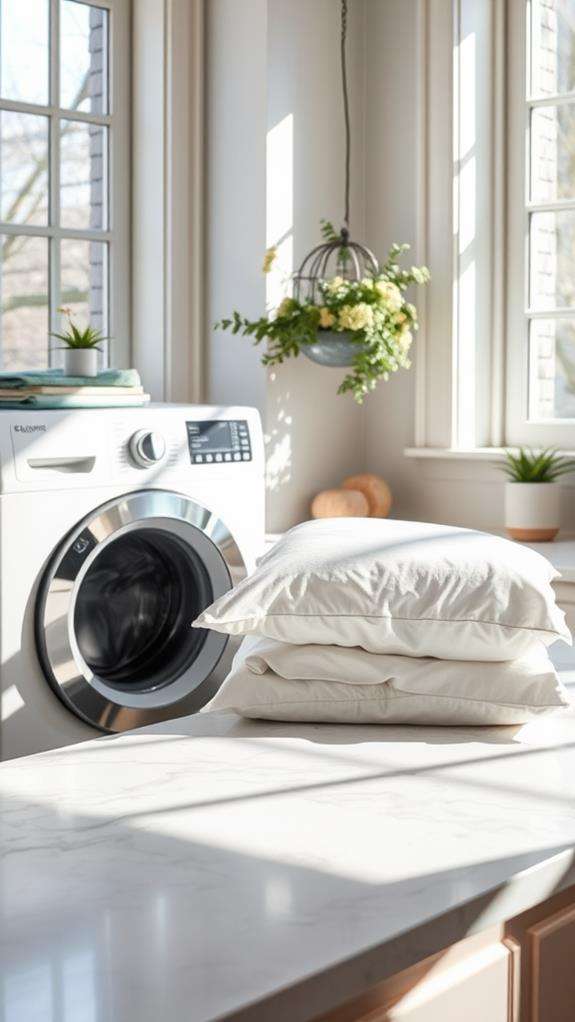
For ideal hygiene, you should wash your pillowcase at least once per week. This essential practice helps prevent the accumulation of dead skin cells, natural oils, and dust mites that can compromise your health and comfort while sleeping. You’ll find that maintaining this weekly washing schedule creates a cleaner, more hygienic sleep environment.
If you’re like many Americans who change their pillowcases only every 24 days, you’re waiting far too long between washes. This extended period allows for significant buildup of contaminants that can affect both your skin health and sleep quality. For those who wear makeup or have naturally oily skin, you’ll need to increase your washing frequency to every 2-3 days, as these factors accelerate the rate of pillowcase contamination.
To maintain proper hygiene, you’ll want to establish a consistent weekly laundry routine that includes your pillowcases. This regular washing schedule isn’t just about cleanliness; it’s an investment in your skin health and overall well-being. By following this simple rule, you’re creating an environment that supports better sleep and reduces potential allergic reactions.
Hidden Dangers of Dirty Pillowcases
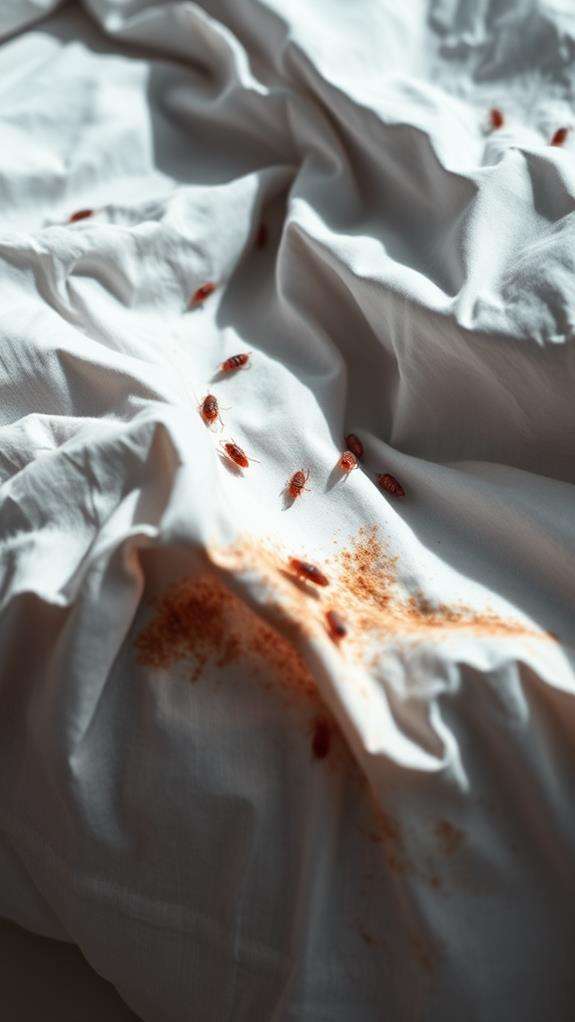
The hidden dangers lurking in your unwashed pillowcase extend far beyond what meets the eye. While you might not see it, approximately 70% of the soil on your pillowcase consists of invisible contaminants, including sweat, dead skin cells, and sebum that accumulate every time you rest your head.
Your pillowcase serves as a breeding ground for dust mites, which thrive on the dead skin cells you shed during sleep. These microscopic creatures and their allergens can greatly impact your skin health and trigger allergic reactions. Here’s what’s really happening on your unwashed pillowcase:
- Bacteria multiply rapidly on accumulated sweat and oil
- Dust mites feed on dead skin cells, creating allergenic waste
- Invisible soil builds up, transferring directly to your face
- Harmful bacteria can trigger or worsen acne breakouts
- Accumulated debris can cause skin sensitivities and irritation
When you notice unpleasant odors coming from your pillowcase, it’s a clear sign of bacterial growth and dirt buildup. These conditions create a perfect storm for skin problems, potentially leading to breakouts, irritation, and other skin issues that could have been prevented with regular washing.
Signs It’s Time to Wash
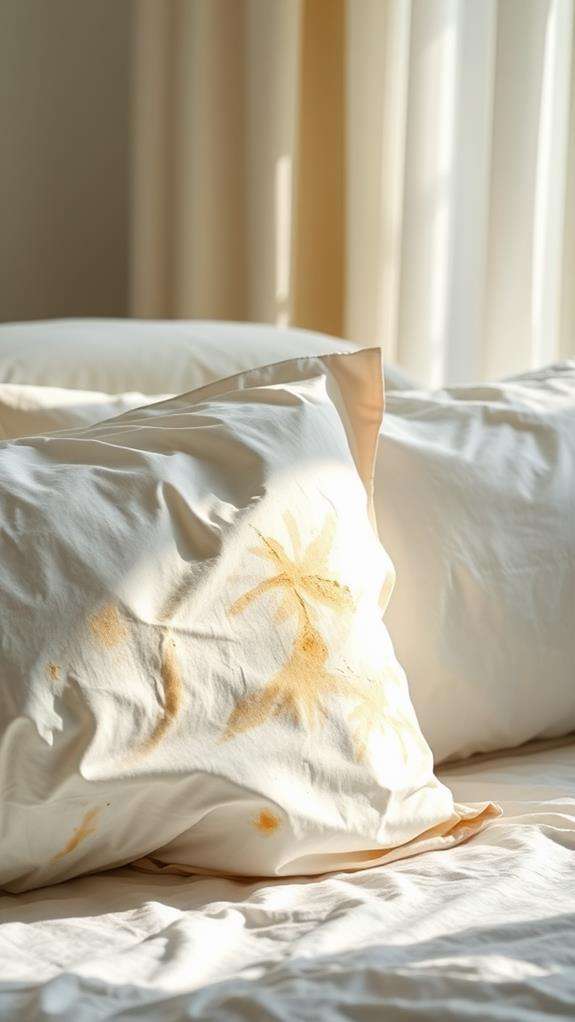
Recognizing when to wash your pillowcase doesn’t require a strict schedule, as several clear indicators can guide your decision. Your senses can be reliable guides, with unpleasant odors serving as a clear signal that it’s time for a cleaning, even if you can’t see the accumulated body soils that are causing the smell.
If you’re noticing skin irritations or unexpected breakouts, your pillowcase might be the culprit. These symptoms often indicate that bacteria and oils have built up on the fabric, making it essential to wash your pillowcases at least weekly. For those who wear makeup regularly, you’ll want to increase the frequency to every 2-3 days to prevent clogged pores and maintain clear skin.
Visible dirt, makeup stains, or any other noticeable marks are unmistakable signs that your pillowcase needs immediate attention. Don’t wait for your regular washing schedule if you spot these telltale signs. While establishing a weekly washing routine is generally recommended, it’s important to trust your judgment when these indicators appear. A quick smell test between scheduled washes can help you determine if an early cleaning is necessary.
Health Benefits of Clean Pillowcases
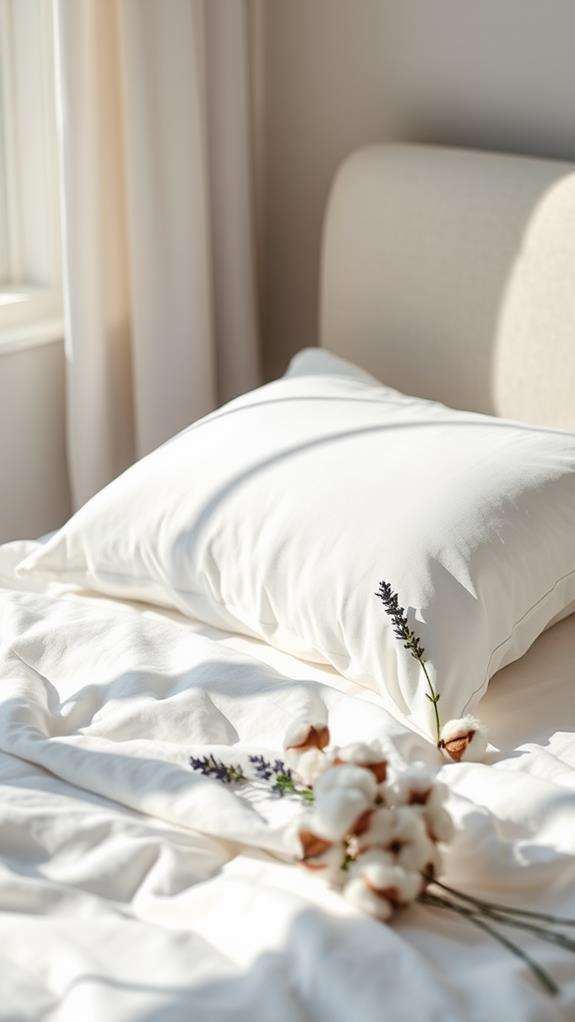
Keeping your pillowcase clean can dramatically improve your skin’s health by preventing the transfer of oils, bacteria, and dead skin cells that often lead to breakouts and irritation. You’ll notice a significant reduction in allergy symptoms, as regular washing eliminates dust mites and other allergens that commonly accumulate in bedding and trigger respiratory issues. Beyond the obvious hygiene benefits, sleeping on fresh, clean pillowcases can enhance your overall sleep quality, as you’re less likely to experience skin irritation or allergic reactions that might disturb your rest throughout the night.
Improved Skin and Complexion
Your skin’s health is directly linked to the cleanliness of your pillowcase, with experts finding a clear connection between regular washing and improved complexion. When you’re not changing your pillowcase frequently, you’re exposing your skin to an invisible buildup of oils, dead skin cells, and bacteria that can trigger breakouts and irritation.
Studies show that maintaining a clean pillowcase schedule can dramatically improve your skin’s health. Here’s what happens when you regularly wash your pillowcases:
- Reduces exposure to accumulated sebum and sweat that can clog pores
- Eliminates bacteria buildup that contributes to acne formation
- Removes allergens that may cause skin sensitivity and reactions
- Prevents residual skincare products from transferring back onto your face
- Decreases the likelihood of cross-contamination from hair products
Reduced Allergic Reactions
Did you know that your pillowcase harbors microscopic threats that can wreak havoc on your respiratory health? Every night, as you sleep, you shed approximately 2 billion dead skin cells that become a feast for dust mites lurking in your bedding. These microscopic creatures, while invisible to the naked eye, can trigger significant allergic reactions through their waste products and remains.
When you wash your pillowcases regularly, you’re doing more than just maintaining cleanliness – you’re creating a barrier against potential allergens that could affect your breathing and skin health. The simple act of weekly washing can dramatically reduce allergic reactions by eliminating accumulated dust mites, their excrement, and the dead skin cells they feed on. If you’re experiencing unexplained respiratory issues or skin irritations, your pillowcase might be the culprit.
To effectively reduce allergic reactions, make it a habit to wash your pillowcases at least once every week in hot water. This practice removes invisible body soils, sweat, and oils that can exacerbate asthma symptoms and allergic responses, helping you maintain better respiratory health and reducing the likelihood of allergic flare-ups.
Better Sleep Quality
Deep sleep quality starts with a fresh, clean pillowcase. When you wash your pillowcases every week, you’re creating an environment that promotes better rest and rejuvenation. Your pillowcase directly affects your sleep experience, as it’s in constant contact with your skin and respiratory system throughout the night.
Clean pillowcases contribute to improved sleep quality in several essential ways:
- Reduces dust mites and allergens that can disrupt your breathing during sleep
- Eliminates bacteria buildup that may cause skin irritations and uncomfortable nights
- Removes accumulated sweat and oils that can create an unhygienic sleeping surface
- Maintains the effectiveness of your nighttime skincare routine
- Creates a fresher, more comfortable sleeping environment
To maximize your sleep quality, you should wash your pillowcases every week. This simple habit prevents the accumulation of dead skin cells, oils, and other debris that can interfere with your rest. When you maintain clean pillowcases, you’re not just protecting your skin – you’re investing in deeper, more restorative sleep cycles. The combination of proper hygiene and comfort directly influences how well you’ll sleep through the night.
Best Washing Practices
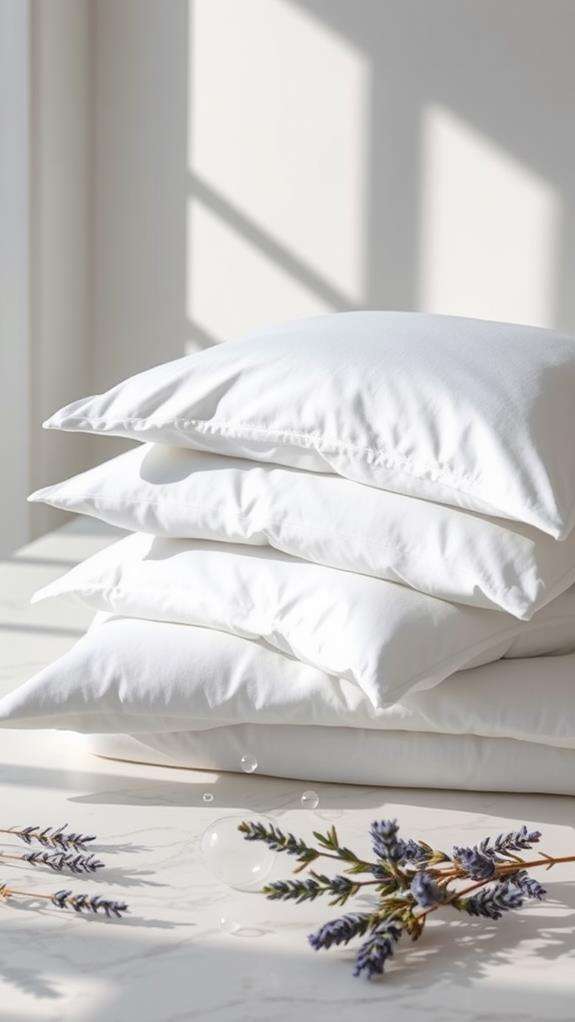
To effectively clean your pillowcases, you’ll want to use hot water between 140-150°F, which helps eliminate dust mites, bacteria, and accumulated oils from your skin and hair. When choosing a detergent, look for enzyme-based formulas that specifically target protein-based stains and allergens, as these are particularly effective at breaking down body oils and dead skin cells. You can boost your cleaning routine’s effectiveness by avoiding overcrowding the washing machine, which allows the pillowcases to move freely and receive a more thorough cleaning.
Hot Water Deep Clean
Getting your pillowcases truly clean requires more than just a quick wash cycle. To effectively eliminate dust mites, bacteria, and built-up oils, you’ll need to implement a thorough hot water cleaning routine. When you wash pillowcases, the temperature should reach between 140-150°F (60-65.5°C) to guarantee proper sanitization.
Follow these essential steps for a deep clean that eliminates harmful allergens and bacteria:
- Select the heavy-duty cycle on your washing machine to provide adequate agitation
- Use enzyme-based detergents that break down protein-based stains and body oils
- Set water temperature to hot (140-150°F) for maximum cleaning effectiveness
- Enable the sanitize option if your machine has this feature
- Check care labels before washing to prevent damage to delicate fabrics
Your washing machine’s sanitize setting can be particularly effective at eliminating unseen contaminants. When you change your pillowcase and wash it properly, you’re not just cleaning fabric – you’re creating a healthier sleep environment. Remember to use the appropriate cycle settings based on your pillowcase’s material, as some delicate fabrics may require special handling despite the need for thorough cleaning.
Detergent Selection Guidelines
Selecting the right detergent plays an essential role in maintaining clean, hygienic pillowcases. When you wash your sheets and pillowcases, it’s vital to choose enzyme-rich detergents that effectively break down body oils, sweat, and accumulated dirt. These specialized detergents target the proteins and oils that dust mites feed on, helping to minimize allergens in your bedding.
Before selecting a detergent, you’ll want to carefully check your pillowcases’ care labels to guarantee compatibility with the fabric type. For best cleaning results, combine your chosen detergent with hot water temperatures between 140-150°F (60-65.5°C). If you’re using bleach, make sure it’s appropriate for your specific fabric to avoid damage or discoloration.
When your washing machine doesn’t have a sanitize function, you’ll need to compensate by using the right detergent concentration and following up with high-heat drying. Don’t fall into the trap of using cold water with minimal detergent, as this combination won’t effectively eliminate bacteria and body soils. Instead, maintain proper detergent levels according to your load size and soil level for the most thorough clean.
Skincare and Your Pillowcase
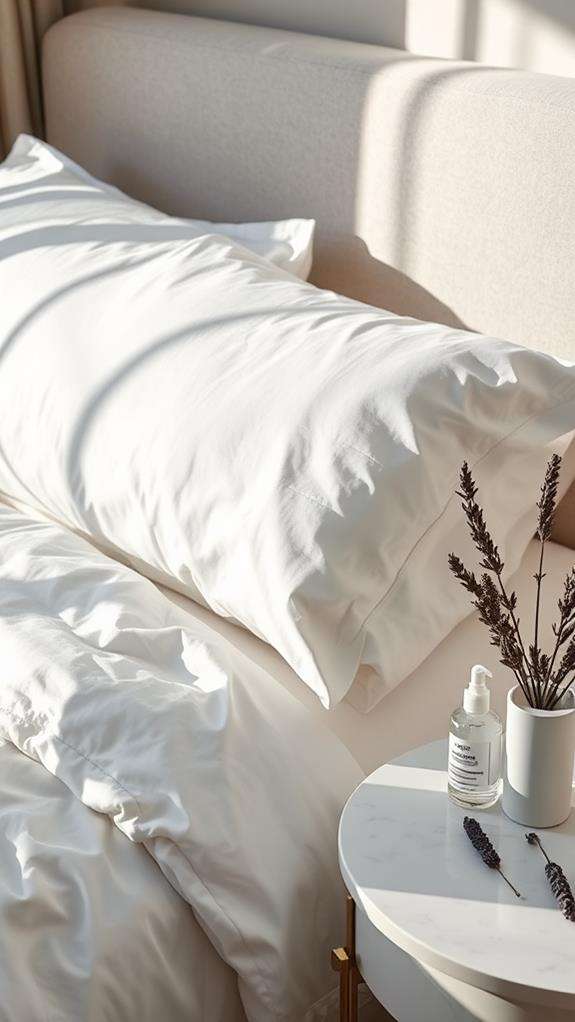
Your pillowcase plays an essential role in maintaining healthy skin that many people overlook. While you’re catching those essential hours of sleep, your face makes direct contact with your pillowcase for approximately eight hours each night. Clean pillowcases can prevent bacterial buildup, reduce acne breakouts, and minimize the risk of an allergic reaction to accumulated dust mites and dead skin cells.
To maintain ideal skin health, consider these essential pillowcase care practices:
- Change pillowcases every 2-3 days if you have acne-prone or sensitive skin
- Wash your pillowcases weekly at minimum, using hot water to eliminate bacteria
- Choose breathable fabrics like silk or bamboo to reduce friction and skin irritation
- Avoid using fabric softeners that can leave residue and potentially clog pores
- Remove makeup thoroughly before bed to prevent product buildup on your pillowcase
Remember that your pillowcase acts as an extension of your skincare routine. The oils from your hair, face products, and natural skin secretions accumulate nightly on your pillowcase’s surface. By maintaining proper pillowcase hygiene, you’re creating a clean foundation for your skin to repair and regenerate during sleep.
Dust Mites and Allergens
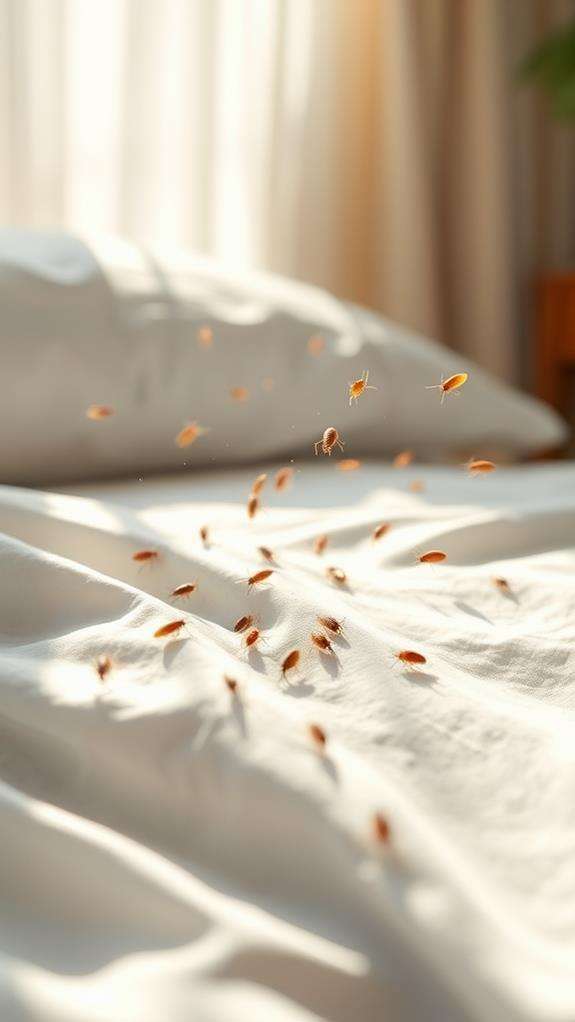
Your pillowcase harbors millions of microscopic dust mites that feed on the dead skin cells you shed while sleeping, making it a hidden breeding ground for potential health issues. These tiny creatures, while invisible to the naked eye, produce allergens through their waste products and decomposing body parts that can trigger respiratory problems, skin irritations, and allergic reactions in sensitive individuals. When you consider that you’re shedding about one ounce of skin every three days and that 70% of pillowcase soil isn’t even visible, it’s clear why addressing this unseen threat through regular washing is essential for your health.
Hidden Health Threats
The hidden world of your pillowcase harbors more than just a comfortable place to rest your head. Every night, you’re sleeping on an invisible ecosystem of allergens, bacteria, and dust mites that could be affecting your health. These microscopic threats multiply rapidly, feeding on the estimated 2 billion skin cells you shed daily.
Here’s what’s lurking in your unwashed pillowcase:
- Dust mite poop contains potent allergens that can trigger respiratory issues and worsen asthma symptoms
- Invisible body soils, including sweat and sebum, make up 70% of pillowcase contamination
- Build-up of bacteria from makeup residue and bodily fluids increases your risk of skin breakouts
- Each pillowcase can host approximately 1.5 million dust mites
- Dead skin cells provide an endless food source for these microscopic pests
To protect yourself from these hidden health threats, you’ll need to change your pillowcases at least once weekly. This simple habit can greatly reduce your exposure to allergens and harmful bacteria. Remember, what you can’t see on your pillowcase could be impacting your health more than you realize.
Fighting Microscopic Invaders
Three key strategies can help you wage war against the microscopic invaders living in your pillowcase. First, establish a consistent weekly washing schedule, as dust mites multiply rapidly while feeding on the dead skin cells you shed every night. Second, use hot water (at least 130°F) when laundering your pillowcases to effectively eliminate these microscopic creatures and their allergens.
If you’re dealing with sensitive skin or respiratory issues, you’ll need to be even more vigilant. The buildup of bacteria, combined with dust mite waste and body fragments, can trigger allergic reactions and skin irritation. This problem intensifies if you have pets, as their dander adds another layer of allergens to your bedding. Consider that you lose approximately one ounce of skin every three days, and about 70% of pillowcase soil consists of invisible debris like sweat and sebum. That’s why your third strategy should be maintaining multiple sets of pillowcases, allowing you to change them more frequently without waiting for laundry day. By rotating fresh pillowcases every few days, you’ll greatly reduce your exposure to these unwanted bedmates.
Choosing the Right Pillowcase Material

Selecting an appropriate pillowcase material can greatly impact both your sleep quality and skin health. Your fabric choice should align with your specific needs, whether you’re dealing with sensitive skin, allergies, or temperature regulation concerns. When you’re considering different materials, it’s vital to weigh their unique properties and maintenance requirements, especially if you want to minimize sweat stain formation and guarantee freshness.
- Silk pillowcases offer superior gentleness on your skin and hair, making them ideal if you’re prone to facial creasing or hair breakage.
- Cotton provides excellent breathability and moisture-wicking, though you’ll need to keep it clean more frequently.
- Bamboo-blend options deliver natural antimicrobial properties and exceptional softness, perfect for allergy sufferers.
- Microfiber resists staining and dries quickly, but may not breathe as well as natural alternatives.
- Hypoallergenic materials can remarkably reduce irritation for sensitive sleepers.
Remember that regardless of which material you choose, maintaining a regular washing schedule is vital. While silk pillowcases might be gentler on your skin, they won’t provide their full benefits if they’re not kept clean. Consider your primary concerns – whether they’re skincare, allergies, or maintenance requirements – when making your selection, and you’ll be better equipped to choose the right pillowcase material for your needs.
Establishing a Cleaning Schedule
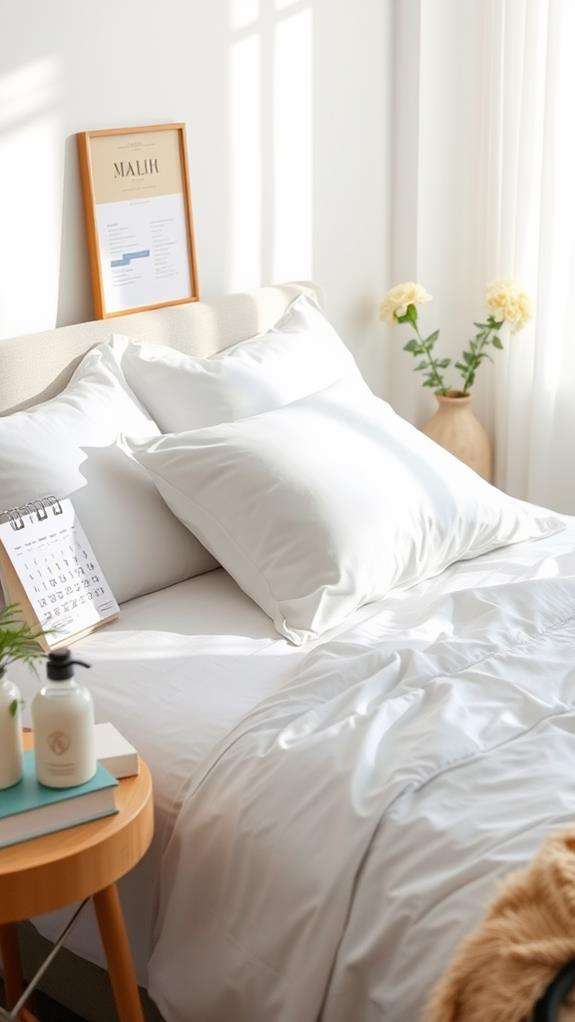
Regularly maintaining a pillowcase cleaning schedule directly impacts your sleep quality and overall health. When considering how often should you wash your pillowcase, experts recommend changing it at least once per week to maintain proper hygiene standards.
You’ll need to change your pillowcase more frequently if you fall into certain categories. If you have sensitive skin, apply heavy makeup regularly, or tend to have oily hair, you should swap out your pillowcase every 2-3 days to prevent bacteria buildup and potential skin issues. Pet owners, take note: you’ll want to establish a more rigorous cleaning routine to combat pet dander and additional allergens that your furry friends bring to bed.
To stay on top of your cleaning schedule, keep a backup set of pillowcases readily available. This makes it easier to maintain your routine without interruption when laundry day gets delayed. Trust your senses, too – if you detect any unpleasant odors coming from your pillowcase, it’s time for a wash regardless of your regular schedule. By establishing and following a consistent cleaning routine, you’ll create a healthier sleeping environment.
Extra Care for Special Fabrics
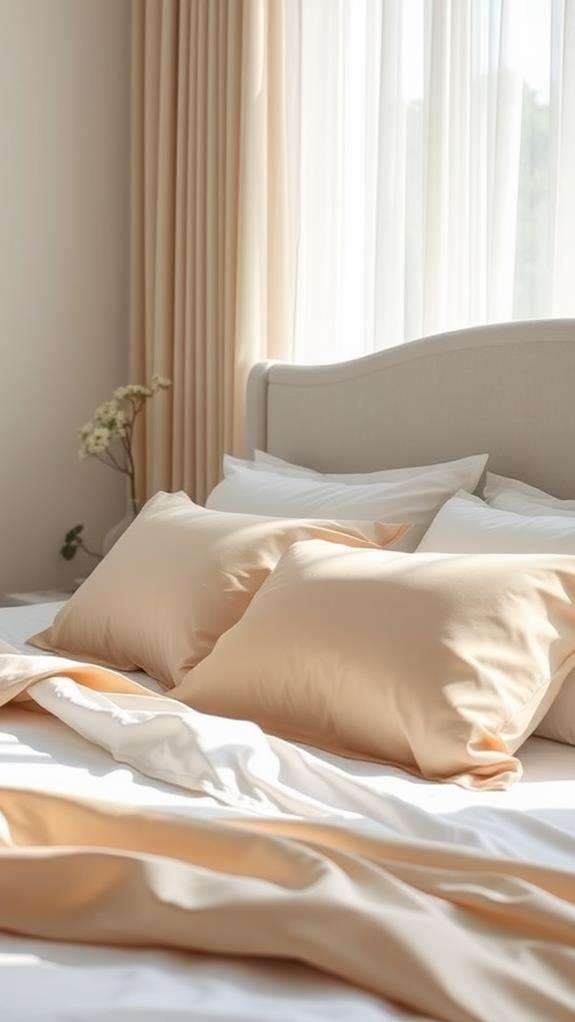
Different pillowcase materials demand specific care to maintain their unique qualities and extend their lifespan. When you’re dealing with specialty fabrics, you’ll need to adjust your washing routine to protect their unique properties and guarantee they last longer. For instance, using a gentle cycle is similar to how you would treat flexible and durable materials like those found in Souper Cubes silicone freezer molds to avoid wear and tear over time.
- For silk pillowcases, opt for gentle, fragrance-free detergents to preserve the fabric’s natural sheen and prevent damage from harsh chemicals.
- With bamboo blends, always use cold water during washing to maintain their antimicrobial benefits and keep them feeling soft against your skin.
- Decorative pillowcases require less frequent washing but should still be cleaned regularly alongside your other bedding items.
- Choose the gentle cycle for knit and flannel pillowcases to protect their texture and prevent stretching or misshaping.
- Skip fabric softeners for all pillowcase types, as they can leave behind residue that may irritate your skin.
Remember that proper care goes beyond just washing frequency. You’ll want to pay attention to water temperature, cycle selection, and detergent choice based on your specific fabric type. By following these material-specific guidelines, you’re guaranteeing that your pillowcases maintain their quality while providing you with clean, comfortable sleep surfaces.
Frequently Asked Questions
How Often Should You Wash Your Pillow Case?
You should wash your pillowcase at least once a week to maintain proper hygiene and protect your skin health. If you have sensitive skin, acne concerns, or tend to sweat heavily at night, you’ll want to change it every 2-3 days. While most dirt isn’t visible, your pillowcase collects dead skin cells, oils, and allergens nightly. Regular washing with deep-cleaning detergent helps prevent dust mites and keeps your sleeping environment clean and healthy.
How Often Should I Wash My Pillowcase to Avoid Acne?
Did you know that 70% of pillowcase soil is invisible to the naked eye? To prevent acne, you’ll want to wash your pillowcase every 2-3 days. If you’re particularly acne-prone, consider changing it even more frequently. Your pillowcase collects dead skin cells, sweat, and bacteria nightly, which can clog your pores and trigger breakouts. For minimal maintenance, you should at least wash your pillowcase weekly, though more frequent washing offers better protection against acne.
What Happens if You Don’t Wash Your Pillowcase?
If you don’t wash your pillowcase, you’ll create an ideal environment for dust mites to feed on your dead skin cells. You’re also letting bacteria multiply on accumulated sweat, oil, and saliva, which can trigger breakouts and skin irritation. If you wear makeup or use skincare products, these residues will build up and clog your pores. Additionally, you’ll notice unpleasant odors developing from embedded dirt and body oils.
How Often Do You Wash a Pillow?
You should wash your pillows every 4-6 months to maintain proper hygiene and extend their lifespan. If you’re using pillow protectors, you might stretch this to 6-8 months. Don’t forget to check your pillow’s care tag first, as different materials need specific washing methods. For machine-washable pillows, use hot water and a heavy-duty cycle. If your pillow isn’t machine washable, you’ll need to spot clean it or have it professionally cleaned.





